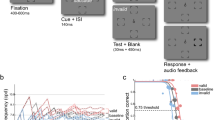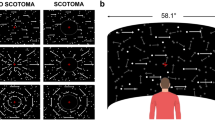Abstract
The visual system has a duplex design to meet conflicting environmental demands: the fovea has the resolution required to process fine spatial information, but the periphery is more sensitive to temporal properties1,2,3. To investigate whether the periphery's sensitivity is partly due to the speed with which information is processed, we measured the full timecourse of visual information processing by deriving joint measures of discriminability and speed, and found that speed of information processing varies with eccentricity: processing was faster when same-size stimuli appeared at 9° than 4° eccentricity, and this difference was attenuated when the 9° stimuli were magnified to equate cortical representation size. At the same eccentricity, larger stimuli are processed more slowly. These temporal differences are greater than expected from neurophysiological constraints4,5,6.
This is a preview of subscription content, access via your institution
Access options
Subscribe to this journal
Receive 12 print issues and online access
$209.00 per year
only $17.42 per issue
Buy this article
- Purchase on Springer Link
- Instant access to full article PDF
Prices may be subject to local taxes which are calculated during checkout


Similar content being viewed by others
References
DeValois, R.L. & DeValois, K.K. Spatial Vision (Oxford Univ. Press, New York, 1988).
Hartmann, E., Lachenmayr, B. & Brettel, H. Vision Res. 19, 1019–1023 (1979).
McKee, S.P. & Nakayama, K. Vision Res. 24, 25–32 (1984).
Lennie, P. Perception 27, 889–935 (1998).
Schmolesky, M.T. et al. Neurophysiology 79, 3272–3278 (1998).
Lamme, V.A. & Roelfsema, P.R. Trends Neurosci. 23, 571–579 (2000).
Azzopardi, P., Jones, K.E. & Cowey, A. Vision Res. 39, 2179–2189 (1999).
Breitmeyer, B.G. Visual Masking (Oxford Univ. Press, New York, 1984).
Reed, A. Science, 181, 574–576 (1973).
McElree, B. & Carrasco, M. J. Exp. Psychol. Hum. Percept. Perform. 25, 1517–1539 (1999).
Carrasco, M. & McElree, B. PNAS 98, 5363–5367 (2001).
Virsu, V., Rovamo, J., Laurinen, P. & Nasanen, R. Vision Res. 22, 1211–1217 (1982).
Bringuier, V., Chavane, F., Glaeser, L. & Fregnac, Y. Science 283, 695–699 (1999).
Girard, P., Hupé, J.M. & Bullier, J. J. Neurophysiol. 85, 1328–1331 (2001).
Rousselet, G.A., Fabre-Thorpe, M. & Thorpe, S.J. Nat. Neurosci. 5, 629–630 (2002).
Acknowledgements
We thank J.M. Hupé, M. Landy, P. Lennie, L. Maloney, D. Pelli and R. Shapley for discussions. A National Science Foundation (BCS–9910734/HCP] grant to M.C. and a National Institute of Mental Health (MH57458) grant to B.M. supported this study.
Author information
Authors and Affiliations
Corresponding author
Ethics declarations
Competing interests
The authors declare no competing financial interests.
Supplementary information
Rights and permissions
About this article
Cite this article
Carrasco, M., McElree, B., Denisova, K. et al. Speed of visual processing increases with eccentricity. Nat Neurosci 6, 699–700 (2003). https://doi.org/10.1038/nn1079
Received:
Accepted:
Published:
Issue Date:
DOI: https://doi.org/10.1038/nn1079
This article is cited by
-
Driving emotions: using virtual reality to explore the effect of low and high arousal on driver’s attention
Virtual Reality (2024)
-
Differential spatial computations in ventral and lateral face-selective regions are scaffolded by structural connections
Nature Communications (2021)
-
Errors in visuospatial working memory across space and time
Scientific Reports (2021)
-
Visual processing speed in hemianopia patients secondary to acquired brain injury: a new assessment methodology
Journal of NeuroEngineering and Rehabilitation (2020)
-
Investigating face and house discrimination at foveal to parafoveal locations reveals category-specific characteristics
Scientific Reports (2020)



